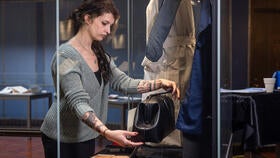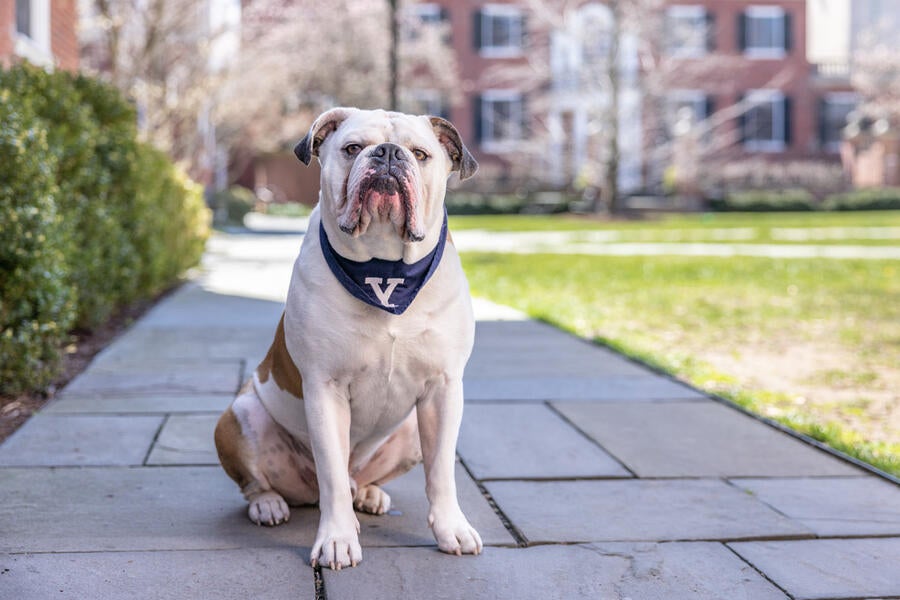
One December morning, the week before finals, Yale Law School (YLS) students looking for a jolt of energy took a study break in Ludwig Hall, the headquarters of YLS’s new Tsai Leadership Program. They chatted over coffee face-to-face but the main draw was at their feet: a fluffy white Pomeranian mix named Jozy, one of two therapy dogs who offer much-needed stress relief for Yale’s law students.
Jozy and his partner are two of six working dogs at Yale, including a service dog, two police detection dogs, and Yale’s famous mascot, Handsome Dan, who attends athletic events and welcomes students and visitors to the university. Whether short- or long-haired, big or small, and irrespective of breed, each pup brings Bulldog spirit to Yale and the surrounding communities.
The people’s pup: Handsome Dan
Yale’s most famous dog and official mascot, Handsome Dan XIX — known as “Kingman” in honor of late Yale president Kingman Brewster Jr. — is a ubiquitous presence: at sporting events and graduations, in staff offices and at the Visitor Center, along pathways and in quads, a living symbol of history and a popular companion in campus selfies.
The two-year-old Olde English Bulldogge continues a more than 130-year tradition at Yale, the first U.S. college to have a live animal mascot. Legend holds that in 1889, undergraduate Andrew Graves, Class of 1892, purchased a pugnacious bulldog from a local blacksmith for five dollars and named him Handsome Dan. This wasn’t the first bulldog at Yale — another, named Harper, preceded him — but he was the first of the Dans, the animal companion who became a fixture at football and baseball games and ultimately part of Yale’s identity.
More to know about Handsome Dan
Kingman enjoys watching the cartoon “Lilo and Stitch,” eating green beans, and playing tug of war. Follow him on Instagram.
In 2021, after a nationwide search that led to a breeder in Maine, Kassandra Haro ’18, program administrator at the Yale Visitor Center and the mascot’s official handler, selected the future Kingman. One of nine in his litter, Handsome Dan XIX was calm, curious, and receptive to petting and play — and, as Kassandra told Yale News at the time, he was also the biggest and most muscular of his litter mates.
Kingman has lived up to his promise. “It’s so fulfilling to see people’s reactions of happiness and joy, and he also provides comfort to those who need it,” Kassandra says. He accepts admiration from students, faculty, and passersby by dropping onto his belly and kicking out his back leg to balance his brindled bulk. Kassandra calls it his “turkey leg.”
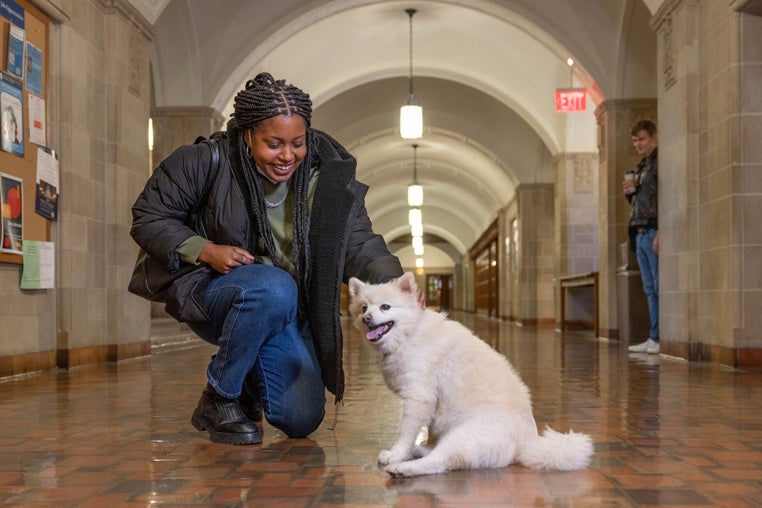 Jozy, in the Law School hallway; photo by Robert DeSanto
Jozy, in the Law School hallway; photo by Robert DeSanto
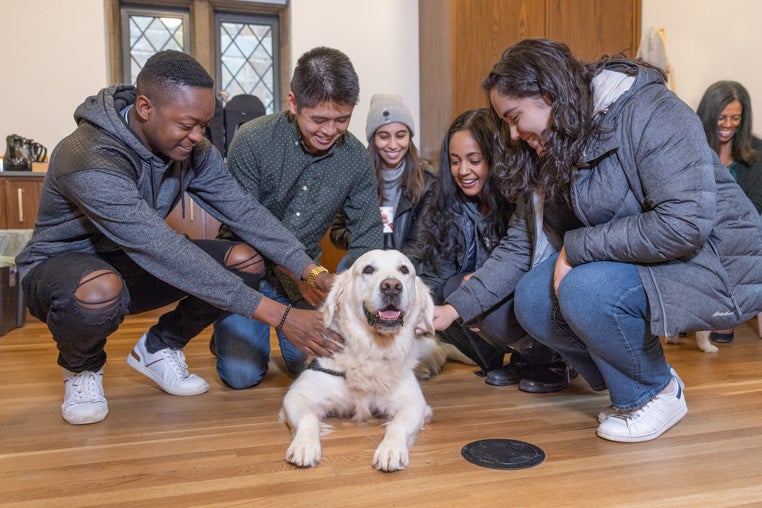 Bodhi meets law students; photo by Robert DeSanto
Bodhi meets law students; photo by Robert DeSanto
Canine therapists: Jozy & Bodhi
“Jozy knows how to work a room,” Christine “Tina” Severson, director of recruitment and administration at YLS and Jozy’s owner, says. “He has a great Pom smile and readily jumps onto laps, bringing light and joy to everyone he meets.”
More to know about Jozy and Bodhi
Jozy’s handler, Tina, is a soccer fan and named him after U.S. Men’s National Soccer Team forward Jozy Altidore. Follow Jozy on Instagram. Bodhi is fascinated by horses; he and Don watch the TV series “Yellowstone” together.
Pet therapy emerged in the 1960s, based on research showing that bonds between humans and animals can be mutually beneficial, enhancing both species’ physical health and reducing stress, among other benefits. Jozy was certified through Pet Partners, a program for both dogs and their handlers that includes training on canine body language, crisis response, and infection prevention, among many other subjects.
“It’s amazing how much people relax and open up around dogs,” says Don Carlson, senior executive director of the Tsai Leadership Program at Yale Law School. Don and his English Cream Golden Retriever, Bodhi, also trained through Pet Partners, and Bodhi recently joined Jozy as a professional therapy dog at YLS. The two regularly spend time with law students during reading week, as they prepare for exams, and participate in meet-and-greet events throughout the year.
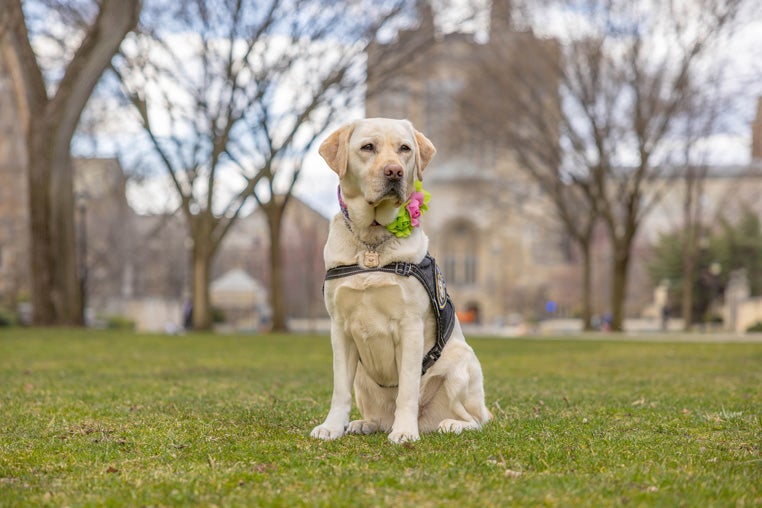 Heidi on Old Campus; photo by Robert DeSanto
Heidi on Old Campus; photo by Robert DeSanto
A calming companion: Heidi
In 2020, Heidi joined the Yale Police Department, where she’s handled by Yale Police Officer Richard Simons. The three-year-old yellow Labrador Retriever, who wears a navy Yale Public Safety harness and a collar adorned with silk flowers, was certified through Puppies Behind Bars, an organization that trains prison inmates to raise service dogs for wounded war veterans, first responders, and law enforcement officers. She completed more than 10,000 hours of training at the Bedford Hills Correctional Facility in New York before she came to the university.
More to know about Heidi
Heidi loves swimming, playing fetch, and getting muddy. She also has her own personalized baseball card, sticker, and bracelet. Join Heidi’s followers on Instagram.
Heidi’s job is to be a calming, comforting presence for students, staff, faculty, hospital patients, and the community at large. She has been a regular at Yale COVID-19 vaccination clinics, helping settle nerves as people get their shots. She’s also worked with children with special needs in Hamden, visited Yale College students celebrating a birthday far from home, and become a friendly fixture at downtown businesses. Heidi is booked every Friday at noon at the Harvey Cushing/John Hay Whitney Medical Library, then heads to Bass Library for “Heidi Fridays.”
“Heidi loves everyone she meets,” Richard says.
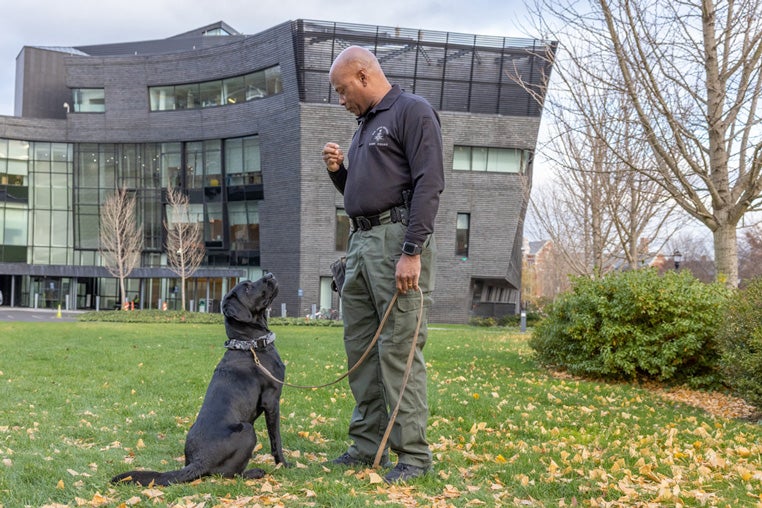 Blue and handler Charles Hebron; photo by Robert DeSanto
Blue and handler Charles Hebron; photo by Robert DeSanto
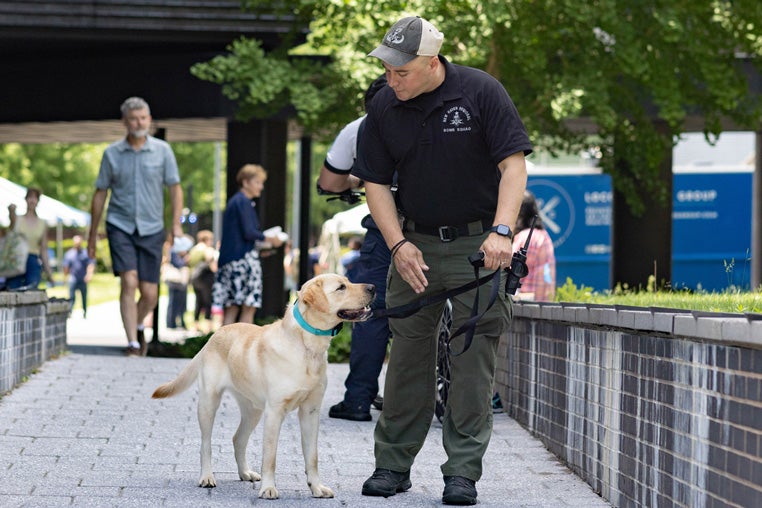 Ivy and handler Daniel Sentementes; photo by Robert DeSanto
Ivy and handler Daniel Sentementes; photo by Robert DeSanto
Detection duo: Blue and Ivy
More to know about Blue and Ivy
Blue loves to play and wrestle other dogs — especially Ivy. Ivy loves playing fetch, hiking, boating, and sleeping on the beach.
Before Kingman — or any human — steps inside the Yale Bowl, the university’s two detection dogs, Blue and Ivy, take the field. These canine detectives work behind the scenes with the Yale Police Department to sweep large events, like Commencement and football games, for explosives.
Yale Police Officer and bomb technician Charles “Charlie” Hebron is the handler for Blue, a four-year-old black Labrador Retriever. Officer Daniel Sentementes handles Ivy, a two-year-old golden English Labrador.
Together, the handlers and the dogs completed a 13-week training program through the State Police Canine Unit at the Connecticut State Police Training Academy, in Meriden. There, Blue and Ivy learned to sniff out explosives through repetition and reward, earning food by searching out traces of hazardous materials. They were also taught to sit when they discover a suspicious substance or package—as Charlie notes, “You don’t want your dog to disturb a potentially explosive bundle.”
Your dog can earn a diploma
“Dogs have incredible success making our human experience better,” says Zachary Silver, Ph.D. candidate in the Department of Psychology, Yale Canine Cognition Center, where he and his colleagues study how canines perceive their environments, solve problems, and make decisions. “We have a predisposition to be happy when we encounter them.”
Your pet can help researchers learn more about how dogs think, learn, and interact with others. Pups can be enrolled in the Canine Cognition Center at Yale, where they’ll participate in enrichment games that help researchers inform canine training for many roles. They’ll earn treats in the process!




